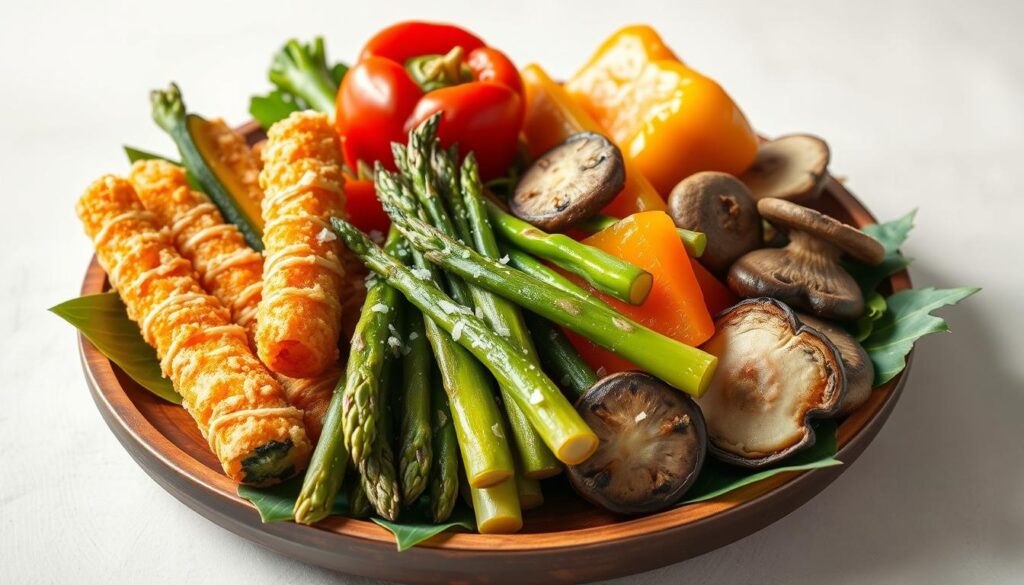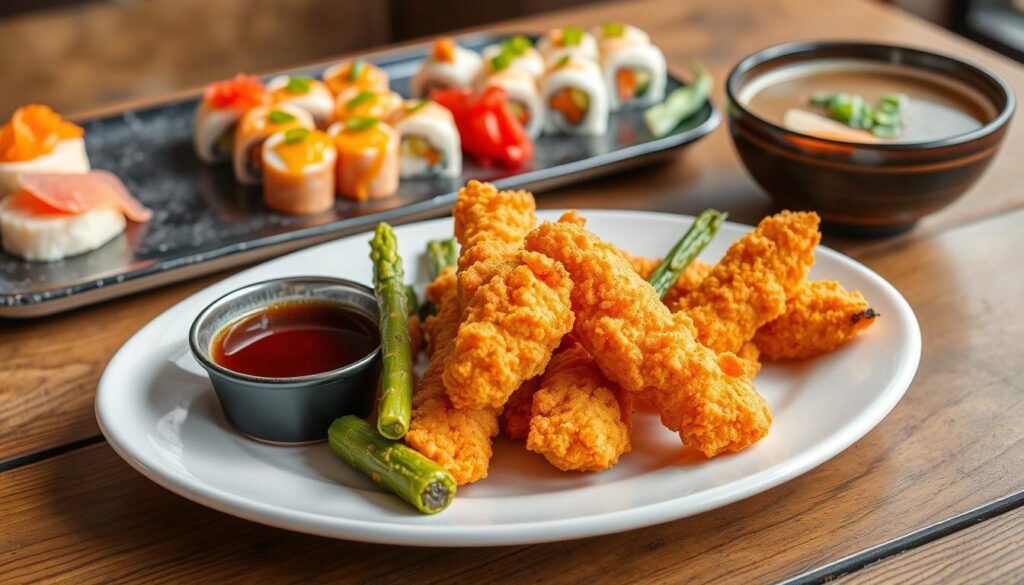The smell of vegetable tempura brings back memories of Tokyo for me. I remember the first time I tried it. Each bite was a burst of flavor. The crispy batter around the Japanese fried veggies was amazing.
This guide will take you through the world of vegetable tempura. We’ll explore its history and the techniques to make it. From its Portuguese roots to its place in Japanese cuisine, we’ll cover it all.
Table of Contents
The Art and History of Japanese Vegetable Tempura
The tasty tempura vegetables we love today have a rich history. It started with the Portuguese influence in Japan. This method, where veggies are lightly battered and fried, is key in Japanese cooking.
Origins in Portuguese Cuisine
In the 16th century, Portuguese brought deep-frying to Japan. They introduced frying battered seafood and veggies. Japanese chefs soon started using local produce in this way.
Evolution in Japanese Cooking
As tempura grew popular, it became a showcase for Japan’s fresh produce. Chefs perfected a light batter to let veggies’ natural flavors stand out. This focus on freshness is a core part of Japanese cooking.
Cultural Significance
Now, veggie tempura are a big deal in Japan. They show the country’s love for cooking and detail. Making tempura is seen as an art, with chefs aiming for the perfect texture.
“Tempura is not just a dish, it’s a way of life in Japan. Every bite is a celebration of the seasons and the delicate balance of flavors.”
Essential Equipment for Perfect Tempura Making
Making delicious tempura at home needs the right tools. You’ll need specialized deep fryers and precision thermometers. Each tool is key to getting that crispy, light texture. Let’s explore the must-have gear for becoming a tempura expert in your kitchen.
Tempura-Friendly Deep Fryer
A dedicated deep fryer for tempura is a must-have. These small, Japanese-style fryers keep the oil at a steady temperature. Look for ones with temperature control and oil filters for the best results.
Tempura Pot and Basket
Traditional Japanese tempura uses a special pot and basket. The pot is shallow, and the basket has holes for easy frying. A good set will make your tempura better.
Digital Thermometer
Getting the temperature just right is key for perfect tempura. A digital thermometer helps you keep an eye on the oil’s temperature. It’s essential for crispy results.
| Essential Tempura Equipment | Why It Matters |
|---|---|
| Deep Fryer | Maintains consistent oil temperature for perfect frying |
| Tempura Pot and Basket | Shallow depth and perforated design for efficient cooking |
| Digital Thermometer | Ensures precise temperature control for crisp results |
With the right tools, you’ll soon be making amazing homemade vegetable tempura From deep fryers to thermometers, each tool is important for those golden-brown veggie treats.
Understanding the Science Behind Crispy Tempura
I love Japanese food, and the science of crispy tempura fascinates me. Temperature control and batter chemistry are key. They help make that perfect, light, and airy texture we all love.
Temperature Control
Frying tempura needs the right temperature. The oil must be hot to seal the batter quickly. But it can’t be too hot, or the inside gets overcooked or greasy. Finding the perfect temperature is all about watching and adjusting the heat.
Batter Chemistry
Tempura batter is more than flour and water. Adding ice-cold water, egg yolks, and a bit of carbonated water makes it light and airy. This helps it stay crisp on the outside but tender inside. Knowing how these ingredients work is key to making crispy tempura.
Oil Selection Impact
The oil used for frying tempura matters a lot. Oils like peanut or canola are best because they can handle high temperatures without burning. They also don’t soak up moisture, keeping the batter crisp and tasty.
| Factor | Impact on Tempura |
|---|---|
| Temperature Control | Ensures proper sealing and crisping of the batter |
| Batter Chemistry | Contributes to the light, airy, and tender texture |
| Oil Selection | Prevents burning and maintains the crispness of the tempura |
Learning about crispy tempura science lets us make perfect Japanese fried treats at home. With the right techniques and ingredients, we can create an amazing culinary experience.
Selecting the Best Vegetables for Tempura
Choosing the right vegetables for vegetable tempura is key to a great dish. The right pick can turn a light, crispy delight into a soggy mess. As a home cook, I’ve found some veggies stand out in this Japanese classic.
Water content is a big factor. You want veggies with moderate to low water to avoid oil absorption. Green beans, carrots, and sweet potatoes are great because they’re firm and dry.
- Green beans: Crisp and slender, they hold their shape perfectly in the hot oil.
- Carrots: Their firm, slightly sweet nature makes them a tempura classic.
- Sweet potatoes: The natural sweetness and starchiness of these tubers create an irresistible crunch.
But veggies with more water, like zucchini or eggplant, need extra care. The right batter and frying can make them shine too.
“The secret to great tempura is in the balance of the batter and the selection of the right vegetables.” – Chef Takashi Yagihashi
Texture and taste also matter. Crisp, firm veggies with mild flavors work best. They let the batter’s lightness shine. Don’t be afraid to try new veggies to find your favorites.

Tempura is all about contrasting textures and flavors. By picking the best vegetables for vegetable tempura, you can enjoy a truly special dish. It’s a celebration of Japanese cuisine.
The Perfect Tempura Batter Recipe
Making the perfect tempura batter is key to that crispy delight we all crave. Whether you’re a pro chef or a home cook, learning to make tempura batter can boost your cooking skills. It takes you straight to the heart of Japan.
Key Ingredients
The base of a great tempura batter is in choosing the right ingredients. Here’s what you need:
- All-purpose flour
- Ice-cold carbonated water or club soda
- Egg yolk (optional)
- Salt
Mixing Techniques
The secret to a light tempura batter is in how you mix it. Follow these steps for the best results:
- Sift the flour into a big bowl to make it airy.
- Whisk in the cold water or club soda gently, without mixing too much.
- If using, beat the egg yolk lightly and fold it into the batter.
- Add a pinch of salt and mix just until everything is combined. The batter should be thin and pourable.
It’s important to mix the batter lightly. Overmixing can make it dense and heavy. Keep your mixing gentle for the best tempura batter.
With these easy steps, you’re on your way to making delicious tempura at home. Try different veggies and enjoy the crispy, golden tempura you create.
Oil Temperature Control Techniques
Getting the perfect tempura frying means knowing how to control the oil temperature. The oil temperature for vegetable tempura is key to making it crispy and delicious. Let’s look at the main ways to keep the temperature just right during cooking.
Keeping the oil at a steady temperature, between 350°F and 375°F, is vital. If the temperature changes too much, your tempura might end up soggy or too dark.
- Use a digital thermometer to check the oil temperature. Check it often and adjust as needed to stay in the right range.
- When adding more tempura, do it slowly. This helps the oil heat up again without dropping too low.
- Keep the oil at a consistent depth. A shallow oil can change temperature too fast. Add more oil as needed to keep it steady.
| Technique | Benefit |
|---|---|
| Adjusting Burner Settings | Regulate the burner heat to keep the oil at the perfect temperature. |
| Preheating the Oil | Start with the oil at the right temperature to avoid big temperature drops. |
| Regulating Batch Size | Fry in smaller batches to prevent the oil temperature from dropping too much. |
By using these tempura frying tips, you’ll get crispy and tasty oil temperature for vegetable tempura every time.
Step-by-Step Vegetable Tempura Preparation
Making perfect vegetable tempura at home is all about balance. You need to prepare, coat, and fry the vegetables just right. Let’s go through the steps to get crispy, golden tempura every time.
Vegetable Preparation
Start by picking fresh, top-quality vegetables. Wash them well and dry them off. Cut the veggies into thin, even slices for even cooking. Don’t overcrowd them, or your tempura might get soggy.
Coating Process
- Make a light batter by mixing ice-cold water and flour. Don’t overmix to keep it airy and not heavy.
- Dip the veggies in the batter, letting any extra drip off before frying.
Frying Method
Keep the oil at about 350°F (175°C) for the best vegetable tempura preparation. Fry the battered veggies until they’re golden and crispy, usually 1-2 minutes. Don’t fry too many at once to keep the oil temperature up and prevent greasy tempura.
| Technique | Importance |
|---|---|
| Uniform Vegetable Slicing | Ensures even cooking and a consistent texture |
| Proper Batter Mixing | Achieves a light, airy coating for how to fry tempura |
| Maintaining Oil Temperature | Crucial for developing a crispy, golden-brown exterior |
By following these steps, you can master the art of vegetable tempura preparation. Enjoy the delightful crunch and flavor of homemade Japanese tempura.
Common Mistakes to Avoid When Making Tempura
Making perfect tempura needs careful attention. I’ve seen many mistakes that can ruin this Japanese dish. Let’s look at common tempura errors and how to avoid them for great taste and texture.
One big mistake is overmixing the batter. A smooth batter is good, but too much mixing makes it dense. Just gently mix the ingredients without stirring too hard.
Another mistake is incorrect oil temperature. If the oil is too cold, the veggies soak up too much oil. If it’s too hot, the outside burns before the inside is cooked. Keep the oil between 350°F and 375°F for the best results.
- Overmixing the batter can lead to a dense, heavy texture.
- Incorrect oil temperature can result in either greasy, soggy tempura or a burnt exterior with an undercooked interior.
- Improper vegetable preparation, such as cutting them too thick or not drying them thoroughly, can compromise the tempura’s crispness.
Lastly, improper vegetable preparation can also ruin the tempura. Cutting veggies too thick or not drying them well stops the batter from sticking. This leads to uneven cooking and a less crisp texture.
By fixing these common mistakes, you can make tempura that’s light and golden. Learning to make tempura is a culinary adventure. Avoiding these errors will make your homemade vegetable tempura a hit with everyone.
Traditional Tempura Dipping Sauces
Tempura is more than just the crispy, golden-brown food. The dipping sauces are key to the experience. Two iconic sauces are tentsuyu and its modern twists.
Classic Tentsuyu Sauce
The tentsuyu sauce is at the heart of tempura. It’s a mix of dashi, soy sauce, and mirin. This blend creates a rich flavor that goes well with the light tempura.
To make the tentsuyu sauce, mix these in a bowl:
- 1 part dashi
- 1 part soy sauce
- 1 part mirin
Stir well, and you have a classic tentsuyu sauce. It’s perfect for dipping your tempura dipping sauce.
Modern Variations
Modern chefs have added their own twists to tentsuyu. Some popular changes include:
- Ponzu Tentsuyu: A mix of tentsuyu and ponzu sauce for a tangy taste.
- Spicy Tentsuyu: Adding chili oil or sriracha for a bit of heat.
- Ginger Tentsuyu: Grated ginger adds a fresh and zesty flavor.
These new takes on tentsuyu let diners try different flavors. They can make their tempura experience unique.
Whether you like the classic tentsuyu or a modern version, the sauce is key. It makes the tempura meal even better.
Seasonal Vegetable Selection Guide
I love making tempura and know picking the right veggies is key. Seasonality changes the taste and texture of our dishes. Let’s look at the best veggies for tempura all year.
In spring, asparagus, peas, and green beans are perfect. Their fresh taste and soft texture are amazing when fried.
Summer brings zucchini, bell peppers, and eggplant to the table. These veggies are juicy and sweet, making great tempura. Try mushrooms like shiitake or enoki for a rich flavor.
Autumn is for heartier veggies like sweet potatoes and squash. They’re sweet and sturdy, making tempura cozy and comforting.
Winter is for root veggies like carrots and radishes. They add a nice crunch and earthy taste. Leafy greens like spinach are also great for a healthy vegetable tempura.
| Season | Recommended Vegetables |
|---|---|
| Spring | Asparagus, peas, green beans |
| Summer | Zucchini, bell peppers, eggplant, mushrooms |
| Autumn | Sweet potatoes, kabocha squash, lotus root |
| Winter | Carrots, radishes, burdock root, leafy greens |
Using seasonal veggies makes tempura even better. Try different mixes to find your favorite flavors and textures. Make your tempura vegetable guide shine with crispy, tasty results.

“The secret to exceptional tempura lies in the vegetables you choose, and the season is your guide.”
Health Considerations and Nutritional Benefits
Tempura is often seen as a rich, indulgent dish. But, with the right methods, it can be a healthy part of a balanced diet. Traditional tempura has a lot of calories from deep-frying. Yet, there are ways to make it healthier.
Caloric Content
A serving of vegetable tempura can have 300 to 500 calories. This depends on the portion size and vegetables used. The batter and oil add most of the calories. But, choosing the right vegetables and frying methods can make tempura healthier.
Healthier Preparation Methods
- Use a lighter, rice flour-based batter to cut down on calories and fat.
- Choose vegetables like zucchini, bell peppers, and eggplant for more fiber and less carbs.
- Try oven-baking or air-frying instead of deep-frying to use less oil.
- Use a low-sodium or citrus-based dipping sauce to add flavor without extra calories.
With a few tweaks, you can enjoy healthy tempura without losing flavor. Focus on using fresh, quality ingredients. This way, tempura can be a tasty and nutritious part of your meals.
| Vegetable | Calories per Serving (3-4 pieces) | Nutritional Benefits |
|---|---|---|
| Zucchini | 150-200 calories | High in fiber, vitamin C, and antioxidants |
| Bell Peppers | 180-220 calories | Rich in vitamin C, vitamin A, and carotenoids |
| Eggplant | 200-250 calories | Low in calories, high in fiber, and a good source of vitamins and minerals |
By choosing healthier vegetables and better cooking methods, you can enjoy tempura’s crispy goodness. This way, you can keep your diet balanced and nutritious.
“Tempura is a culinary art form that can be enjoyed without sacrificing your health. With a few simple tweaks, you can satisfy your cravings for this iconic Japanese dish while nourishing your body.”
Pairing Vegetable Tempura with Other Dishes
Vegetable tempura is a versatile dish that pairs well with many Japanese dishes. It’s a key part of traditional meals, adding flavor and texture to the table.
One classic way to enjoy tempura is with tentsuyu, a savory sauce. This sauce, made from dashi, soy sauce, and mirin, highlights the tempura’s crispiness. For a twist, try it with spicy mayonnaise or ponzu.
Tempura goes great with other Japanese favorites, like:
- Steamed rice: Its light texture complements the tempura’s crunch.
- Miso soup: The rich broth of miso soup pairs well with fried tempura.
- Sashimi or sushi: Raw fish and tempura together create a bold flavor mix.
For something new, try tempura in fusion dishes, like:
- Tempura-battered fish tacos
- Vegetable tempura sushi rolls
- Tempura-topped salads or bowls
Exploring different pairings with vegetable tempura opens up endless possibilities. It’s all about finding the right mix of flavors and textures for a great meal.

| Pairing | Complementary Flavors | Culinary Tradition |
|---|---|---|
| Tempura and tentsuyu | Savory, umami | Traditional Japanese |
| Tempura and miso soup | Earthy, comforting | Traditional Japanese |
| Tempura and sashimi/sushi | Delicate, fresh | Traditional Japanese |
| Tempura-battered fish tacos | Crispy, zesty | Fusion (Japanese and Mexican) |
“The true essence of tempura lies in its ability to seamlessly integrate with the broader canvas of Japanese cuisine, creating a harmonious and delightful dining experience.”
Storage and Reheating Tips
Homemade vegetable tempura can be enjoyed for days, not just during the meal. Proper storage and reheating can keep it crispy and flavorful.
Proper Storage Methods
To keep your tempura fresh, follow these tips:
- Let the tempura cool down completely before storing.
- Put it in an airtight container or a resealable plastic bag.
- Don’t stack the pieces to avoid sogginess.
- Keep it in the fridge for up to 3 days.
Reheating Techniques
Ready to enjoy your leftover tempura? Here are ways to reheat it without losing its crunch:
- Oven method: Preheat to 400°F (200°C). Place on a baking sheet and bake for 5-7 minutes, flipping halfway.
- Air fryer method: Set to 380°F (190°C). Reheat for 2-3 minutes until hot and crispy.
- Stovetop method: Heat oil in a skillet over medium-high. Fry the tempura for 1-2 minutes per side.
By using these storage and reheating tips, you can enjoy your homemade vegetable tempura for longer.
Restaurant vs. Homemade Tempura Comparison
I love tempura and have tried both restaurant and homemade versions. Each has its own special qualities. Let’s dive into the differences in how they’re made, what goes into them, and the dining experience.
Top Japanese restaurants make tempura with great care. Their chefs have years of experience. They use a light batter that makes the vegetables taste fresh and crisp.
The oil is heated just right, so each piece is cooked perfectly. This makes the tempura at these places truly special. It’s a mix of amazing flavors and textures.
Making tempura at home is a different story. You get to play with ingredients and seasonings. You can make it just how you like it. It might not look as good as restaurant tempura, but making it yourself is very rewarding.



